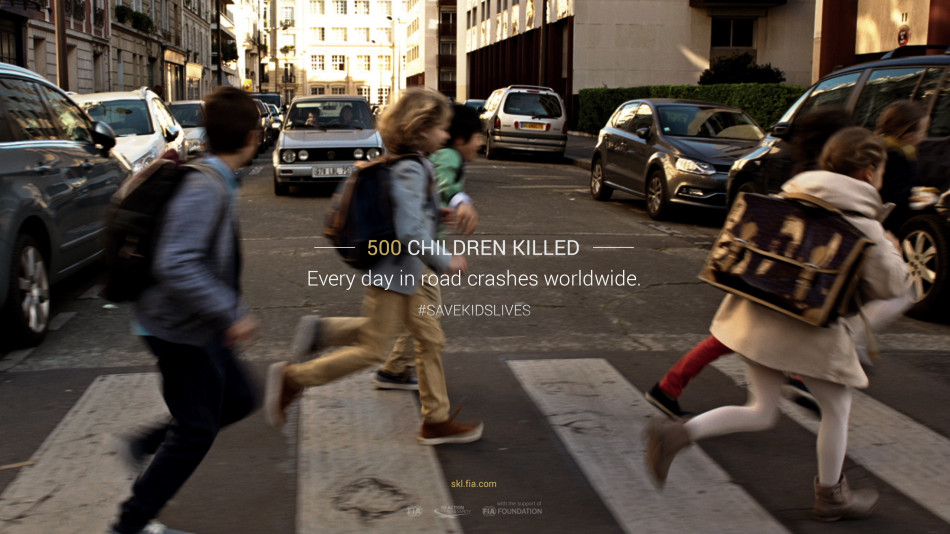FROM AUTO #12: Moving Pictures

It’s clear that this is going to end in tears. Something bad is going to happen to these innocent children making their way to school. Luc Besson’s camera flicks back and forth between two groups of kids, one in the streets of a posh Paris neighbourhood, the other in a sprawling suburb of a town in South Africa.
The French children chat and laugh as they stroll, apparently safe on the clearly defined pavements and zebra crossings that ease their path to the other side of the road. The South African children have no such luck. They have to walk along dusty tracks and are then faced with a busy highway where vehicles hurtle past them in both directions.
“It was the perfect road for our purposes,” says Fanny Besson, Luc Besson’s sister and the producer of the three-minute film he was commissioned to make by the FIA as part of its ongoing road safety campaign.
By ‘perfect’ she means that there are neither zebra crossings nor traffic lights, and the South African children have no choice but to risk sprinting across whenever they spot a break in the traffic.
Therefore it was ‘perfect’ to illustrate the risks that millions of children across the world face on their daily trek to school.
Yet, in this film, it is in Paris that tragedy strikes. One of the children kicks a ball into the road, runs after it and is hit by a car.
The message, delivered by the following text interspersed with the images, is simple:
Every Day
Children Walk to School
Every Day
500 of them will not make it.
Save Kids Lives.
The theme of the film supports this year’s United Nations Global Road Safety Week, which took place in May. Its message was #SaveKidsLives to highlight the appallingly high number of children who become victims of road accidents.
The statistics are shocking. An estimated 1.3 million people are killed each year on the roads worldwide and 50 million more are injured. That means that 3,000 people die every day in car accidents of some sort. And 500 of them are children.
For children aged 15–17, there is no greater threat to their lives than a road traffic accident. And children’s chances of dying on a road are far higher if they live in a less well-off part of the world – 95 per cent of road traffic fatalities among children occur in low- and middle-income countries.
However, as Besson reminds us in his film for the FIA’s Action for Road Safety campaign, cars can be deadly even in supposedly safe cities.
Of the two countries featured in the short film, France suffered 3,992 road deaths and South Africa 15,995 according to a comparative chart compiled by the World Health Organization for the year 2010. But those figures pale when compared to the death toll in China, which topped the list with an astonishing 275,983 road deaths that year. India was in second place with 231,027 fatalities, followed by Nigeria at 53,399 and Brazil at 43,869. The United States, where 35,490 road deaths were reported in 2010, was the only developed Western nation to appear in the top 10 countries with the worst road accident records.
GETTING THE MESSAGE ACROSS
The carnage on the world’s roads represents an unacceptable – and eminently avoidable – human, economic and social cost for societies, and the FIA has associated itself with the United Nations in the world body’s fi ght against it.
In 2011 the UN launched what it called the Decade of Action for Road Safety. Its aim was to save five million lives and reduce road-related injuries by 50 million worldwide over the next 10 years. The initiative calls on governments to embrace what the UN calls the Safe System Approach, which encourages both road users and the authorities who design and maintain the road transport system to share responsibility for safety.
Governments are urged to crack down on speeding and drinking and driving, to ensure that seat-belts are worn in cars, to build roads that are safe for both drivers and pedestrians, and to oblige car manufacturers to produce vehicles with appropriate safety features.
Yet in many countries these goals remain far off , as roads are packed with unsafe vehicles and drivers often get away with speeding or other dangerous practices because they can bribe police officers to turn a blind eye.
That is what the UN’s Decade of Action for Road Safety is aiming to change. To support the world body’s initiative, the FIA created its own Action for Road Safety campaign. Through its global network of motoring and touring clubs, which have become leading voices for road safety in their respective countries, the FIA encourages governments to make road safety a national priority.
FIA-sponsored road safety initiatives have been started in more than 60 countries: awareness campaigns, educational programmes and training, vulnerable road users’ protection, conferences, events and workshops, road infrastructure safety information and vehicle inspection programmes.
The FIA has also produced a series of short fi lms aimed at increasing road safety awareness. But with the commissioning of Luc Besson, this is the fi rst time that the federation has turned to an A-list movie director.
Besson has for many years been a friend and collaborator of FIA president Jean Todt, whom United Nations Secretary General Ban Ki-moon in April this year nominated as his Special Envoy for Road Safety.
Several years ago, Besson and Todt helped found a brain and spine research centre in a Paris hospital, the Institut du Cerveau et de la Moelle Epinière. It has become one of the leading institutes for brain and spinal research in the world.
The French director of box-office hits such as The Big Blue, The Fifth Element, The Lady and Taken, made a specially commissioned short film in 2013 for the FIA’s annual Prize-Giving Gala. Titled The Heist of the Century, it featured some of motor sport’s most celebrated drivers – such as Sebastian Vettel, Michael Schumacher and Alain Prost – playing bandits involved in an audacious robbery. For his latest collaboration with the FIA, he has produced a much more sombre video.
It aims to grab public attention worldwide in September when the UN General Assembly will vote in New York for the post-2015 Sustainable Development Goals and in November at the second Global Road Safety Ministerial Conference, held in Brasilia.
The film was shot over four days – two in the chic 7th arrondissement of Paris and two in the town of Wellington in South Africa, which lies about 70 kilometres inland from Cape Town – and involved a professional crew helped by around 30 students from the film school set up by Besson in the Paris suburbs.
Maxime and Charline were two of the nine-year-old children acting in the Paris episode that was shot over a couple of sunny spring days earlier this year. They were having a lot of fun being stars for the day – and were thrilled to get some time off school. But they both said they knew the message of the short movie was a very serious one. “I think the film will work because Luc Besson is a really famous director, so people will definitely talk about this video,” said Charline

 Facebook
Facebook Twitter
Twitter






